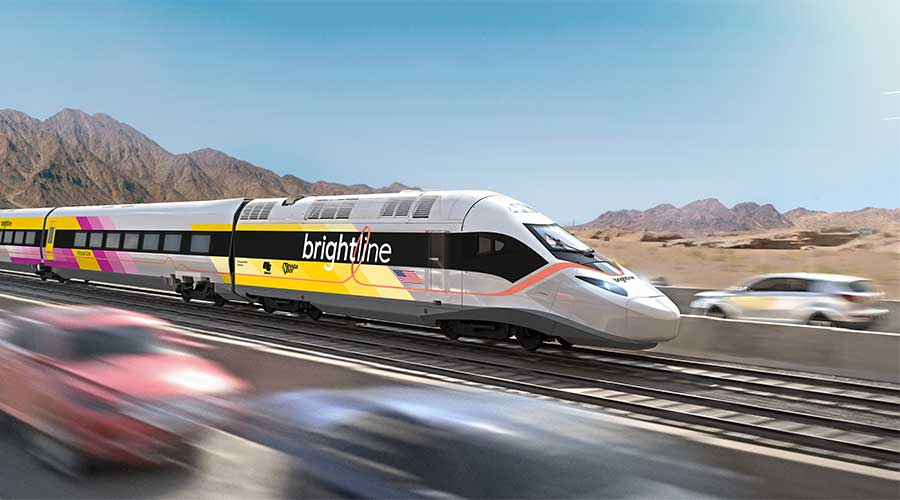Stay updated on news, articles and information for the rail industry
July 2007
Rail News: Passenger Rail
At Caltrain, running electric multiple units is a key component of the agency's long-term growth plans
— by Angela Cotey, Associate Editor
When Mike Scanlon became Caltrain's executive director more than seven years ago, he moved from Fort Lauderdale, Fla., to the San Francisco peninsula, a place he remembers as being "completely insane" at the time.
"You had, at that time, a hiring boom — I remember there being cocktail parties in San Francisco and San Jose, and they'd hire people on the spot to take jobs," he recalls, leaning back in a chair in his San Carlos, Calif., office. "I mean, there was literally no unemployment."
After all, it was the turn of the century in the heart of the Silicon Valley, home to many new Internet and software providers. The economy was booming and the real estate market was thriving — and traffic congestion was at an all-time high. So was Caltrain ridership, which topped out at 35,000 daily passengers.
But when the NASDAQ stock market plummeted in 2000, so did the Silicon Valley economy, and the so-called "dot-com bust" hit — and hit hard. The post-9/11 economic downturn further contributed to the region's woes.
"We went from 35,000 daily riders to roughly 25,000 in a hurry," says Scanlon, who previously served as CEO of Broward County Transit. "And obviously the sources of a lot of our funding — our partner agencies — were going down, too. In San Mateo County, a half-cent sales tax we derive a lot of our revenue from dropped from $70 million to $50 million."
The tough times might have affected ridership and revenue, but they didn't impact a plan Caltrain already had in place to implement express service along the majority of its 77-mile San Francisco-to-Gilroy, Calif., commuter-rail corridor. And agency officials believed the new service would bring some of those lost riders back.
In 2002, Caltrain began upgrading its signal system and building two additional tracks at the quarter points of the double-track railroad, enabling the agency to launch Baby Bullet express service in June 2004. The trains make limited stops and reduce trip times between San Francisco and San Jose — the railroad's two primary destinations — from an hour and 20 minutes to less than an hour.
In August 2005, Caltrain added even more express service, bringing the total number of weekday trains it operates to 96. The faster trains and increased service have helped attract 32 percent more riders during the past three years, roughly putting Caltrain back to the 35,000 daily passengers it was carrying pre-dot-com bust. And revenue is up 80 percent.
"Where a few years back when the freeways were jam-packed and people had no choice but to take the train, we have people now who could drive. The population has dropped," says Robert Doty, Caltrain's director of rail transportation, engineering and construction. "We've started pulling people to the system."
Coming To A Head
But if ridership continues growing at its current pace, it won't be long before Caltrain's capacity is maxed out. Like many U.S. urban areas, the San Francisco peninsula's population and employment is expected to soar during the next 20 years, and Caltrain officials project service demand will triple during that timeframe — and the system will reach capacity within five years.
So, it appears things are about to get "insane" on the peninsula once again. To make sure they're ready, Caltrain officials had to do a little out-of-the-box thinking.
"What we really needed to do was look at the entire way we operate," says Doty. "We needed to come up with a plan that will allow us to unconstrain the system."
That plan is Caltrain 2025 (formerly Project 2025), a $3.9 billion long-range strategy to meet the agency's capacity vs. demand challenge. Part of the plan is pretty run-of-the-mill: bring the system to a state of good repair, redesign several stations to handle more traffic, improve grade crossings and electrify the corridor. The other part is, well, unique.
Caltrain officials have proposed operating electric multiple unit (EMU) vehicles along the corridor — think subway cars operating on open track rather than in tunnels. The lighter-weight vehicles would stop and start much quicker than Caltrain's diesel locomotives, enabling the agency to improve travel times and, therefore, add more trains.
"Basically, we threw out everything and said, 'Let's start from zero. Let's not assume anything,'" says Doty. "So we took this crazy idea and came up with what we think is the best system for our service model and found out that maybe it will be acceptable."
The key word is "maybe." The EMUs Caltrain wants to operate aren't Federal Railroad Administration-compliant; the vehicles don't meet the administration's crashworthiness standards. To operate the EMUs, Caltrain would have to obtain a waiver from the FRA. If the FRA grants it (and Caltrain officials believe there's a good chance they will), Caltrain would be the first commuter-rail agency to obtain permission to operate non-compliant vehicles, says Doty.
In turn, Caltrain could propel its service to a whole new level, operating faster trains and more frequent service. It's a lofty goal, but if you can't think innovatively in the Silicon Valley, where can you?
"What you have is a huge potential to take a commuter railroad and run it like a rapid transit," says Doty. "We're really stretching the boundaries."
Creating The Vision
Caltrain 2025 began taking shape in fall 2005, when Doty and several other Caltrain officials began meeting every Wednesday morning to discuss their vision for the railroad and determine how to best execute it. Thinking outside the box turned out to be easier said than done.
"You tend to think first about equipment and infrastructure solutions, and that was the biggest transition — to get people thinking about systems solutions," says Doty. "That was a massive change of thought pattern. We have drawings galore of how many tracks we can put in different places along the railroad, but when you sit down and look at it, you realize it doesn't get you anywhere. Why would you add more track only to go into a bottleneck?"
In Caltrain's case, capacity is constrained by factors such as track curvatures, particularly heading into the San Francisco terminal, and freeway piers along the right of way that prevent them from adding track in certain areas.
So after 11 months of planning, officials presented the Caltrain 2025 plan to Caltrain parent agency the Peninsula Corridor Joint Powers Board in August 2006. The plan calls for adding track only in one location: between Santa Clara and Diridon, a corridor Caltrain shares with Amtrak, Altamont Commuter Express and Union Pacific Railroad trains.
"Right now in Diridon, we make a train movement in the peak every two minutes, and if one of them's not right on, it cascades," says Doty. "So we've got to rebuild that and reconfigure it to have more flexibility."
On the other end of the system, Caltrain needs to reconfigure the North Terminal in San Francisco. The agency is in the midst of completing some intermediate upgrades — such as adding crossover tracks, and replacing or rehabilitating 18 switches — that will get them through another 10 years or so, says Doty. But the terminal is "probably as poorly designed as a station can be," he says, with narrow platforms and very few alternate alignments to move in and out of the station. And, all passengers enter and exit the platform through one set of doors, meaning Caltrain can't simultaneously load and unload trains.
So, the agency will spend $126 million to upgrade and rehabilitate the station, including adding a mezzanine to enable passengers to board from the top and bottom, and widening platforms.
Caltrain also will eliminate its three remaining "hold-out" stations, where the right of way narrows and only one train can serve the station at a time. In addition, the agency will replace 11 bridges, upgrade crossings, improve signal and communications systems, and rehabilitate track.
Going Electric
Electrifying the railroad is a key Caltrain 2025 component, as well. Once that's complete by 2014, the agency will have a few rolling stock options. At the very least, Caltrain would replace its diesel locomotive fleet with electric locomotives, which are more efficient and offer higher performance than diesel locomotives.
Or, the agency could operate FRA-compliant EMUs, but such a vehicle currently doesn't exist — at least not one that meets Caltrain's standards.
"We've looked for compliant EMUs with the characteristics we need, like number of seats and length of cars, and we can't find one," says Doty. "And with current crashworthiness standards, you have to have more body strength and by definition that reduces performance because the more weight you have, the slower you take off and the slower you stop."
So, to get the most benefit out of its soon-to-be-electrified corridor, Caltrain is proposing to run non-compliant EMUs — a first for a U.S. commuter-rail agency, says Doty. Not that Caltrain's proposing an entirely new concept. The vehicles actually would be compliant with UIC crashworthiness standards (that is, European standards).
"What we're really talking about is more of a European-type model — a lighter piece of equipment that has higher performance and higher reliability, more like what you would see on an enclosed system like BART or WMATA," he says. "[EMUs are] the least expensive, least risk way of getting where I need to go, and I can do it without building much more infrastructure. We can improve performance, and that means we're getting more back from our investment."
But it's currently against FRA regulation to operate such vehicles in a U.S. heavy-rail environment. The vehicles don't meet the agency's more stringent crashworthiness standards and therefore, can't operate on the same track as FRA-compliant vehicles — in other words, other passenger- and freight-rail trains that operate on the same corridor as Caltrain.
UIC-compliant vehicles feature a crash energy management system designed to absorb energy during an impact, so there's no need to build a heavy steel frame. In the U.S., passenger-rail cars have about 800,000 pounds of "buff strength"; European rails cars have buff strength of about 400,000 pounds, says Doty.
"If you think of automobiles 10 years ago, they had these big strong, steel bumpers. Now, the whole front end is designed to absorb impact," he says. "We're essentially trying to do the same thing. You can get by with a lighter vehicle because you don't have to build a heavy buffer."
The Rule Book
However, current FRA regulation states that lightweight vehicles "are not designed to be used in situations where there is a reasonable likelihood of a collision with much heavier and stronger conventional rail equipment" and "given the structural incompatibility of light rail and conventional equipment, FRA has grave concerns about the prospect of operating these two types of equipment simultaneously on the same track," according to Part 211 of the federal rail safety regulations.
Caltrain's solution? Eliminate the possibility of a collision.
"It's why they don't put bumpers on airplanes. You design the system so that cars don't hit each other," says Doty. "It's no different than what you have in rapid transit already, but we need to move it over into the heavy-rail environment. If you took the same systems protection you have on BART and apply it to what we have, you would have collision avoidance."
Specifically, "collision avoidance" is a type of positive train control (PTC) that incorporates limitations such as stopping distances and speeds into the track infrastructure, Doty says. PTC alerts the operator when the vehicle gets too close to another vehicle or if they're exceeding speed limits. If the operator doesn't respond in time, the system will take over. It would cost about $30 million for Caltrain to implement PTC, Doty says.
Several types of PTC currently are being tested in the U.S. and Caltrain is looking into all of them to determine what best fits its needs, says Doty. Caltrain's also looking into the European Train Control System, the European standard railroads are implementing to ensure interoperability of the European high-speed rail system.
Necessary Steps
Now, Caltrain has to apply for a waiver from current regulations through the FRA, which couldn't comment on Caltrain's plans because, as of press time, the administration didn't have details on it.
"They're still in their planning stages," says FRA spokesman Steve Kulm. "They haven't sought a waiver from us spelling out specifically what they want to do."
However, preliminary discussions with the FRA have been "favorably received," says Doty, who believes that if ever there were a time to convince FRA officials to lift the regulation, it's now. As traffic congestion and environmental issues continue to mount, and rail capacity reaches its limits, freight and passenger railroads and federal agencies recognize they need to attract customers by improving their service models, he says.
"[Freight railroads] are capacity constrained, too, and they have two choices — they could build more infrastructure, or they could go to a systems solution," says Doty. "Well, guess what? The system solution that will increase their throughput is the same system solution I need to run mixed traffic. So all of a sudden, these things are starting to click."
Also possibly working in Caltrain's favor: The agency wasn't the first to seek permission to operate non-compliant vehicles. In early 2007, the California High Speed Rail Authority (CHSRA) approached the FRA about using non-compliant equipment along their proposed statewide system. So when Caltrain officials went to the FRA about a month after high-speed officials and proposed essentially the same thing, administration officials already had non-compliant vehicles on the brain.
"Here you have the FRA, who's being asked to solve the high-speed problem on a national basis, and little old us, who's saying, 'We have demand we can't meet — can we come up with a solution based on collision avoidance?' And the FRA said 'yes' for the first time ever," says Doty.
High Speed Tie-In
Now, Caltrain and CHSRA are working with the FRA to develop that solution. In mid-June, the parties met to determine how to proceed with the EMU proposal. FRA officials asked Caltrain and CHSRA officials to develop a formal safety case for a collision avoidance system, as well as a collision mitigation plan for grade crossings.
Caltrain and CHSRA will be working closely together to determine the best possible solution; Caltrain's board has mandated the agency's equipment and infrastructure be compatible with high-speed rail, so when the state eventually launches a high-speed system, CHSRA "just has to show up with the equipment," says Doty. And, the FRA will be working with Caltrain and CHSRA throughout the process.
If the FRA does approve Caltrain's EMU proposal, the agency will be able to run a much different — and much more efficient — operation than it does today. With improved travel times and faster starting and stopping capabilities, Caltrain could run more of a headway service, serving stations every 10 or 15 minutes, instead of operating its current scheduled service. The improvements would help Caltrain attract at least three times more riders, the agency estimates. And, if Caltrain does obtain FRA approval to operate non-compliant EMUs on its line, it could set a standard for other commuter-rail agencies to follow.
"If we can achieve everything set forth in Caltrain 2025, we will have a true, European-style rapid transit system," says Scanlon. "We'll make the transition from commuter rail to rapid transit. Our long-term view is to make this a prototype for how to run a commuter railroad in this country. We're thinking rather boldly."
A New Solution To An Age-Old ProblemDeveloping a proposal to operate non-compliant electric multiple units on a commuter-rail corridor required some out-of-the-box thinking on Caltrain officials' part — but it wasn't the first time agency execs pitched a unique idea. After launching Baby Bullet express service in June 2004, riders began flocking back to the system. But a looming budget deficit — to the tune of $13.6 million for FY2005 — put a damper on the Baby Bullet success. The easy solution would be to cut back expenses and service, right? Caltrain officials didn't think so. "We went to the board and, like they always do, they said, 'Cut everything to balance the budget.' And what we proved is that we couldn't," says Robert Doty, Caltrain's director of rail transportation, engineering and construction. "You have so much cost you have to pay for that [you would] take your best service away first and actually make it worse. So in a miraculous board meeting I'll never forget, we proposed the opposite. We said, 'Let's add service.' And our board said, 'OK.'" So in August 2005, Caltrain expanded its 76-train schedule to 96 weekday trains. Since the Baby Bullet introduction and subsequent service increase, ridership has grown 32 percent and revenue, 80 percent — despite three fare increases, one of which hiked ticket prices a whopping 17.5 percent. "The fare increases defied all of what you'd expect — pushbacks, elasticity … we saw absolutely none of that," says Scanlon. "Ridership just kept continuing to grow." That's because even though ticket prices were going up, Caltrain was providing a better product, so to speak, says Scanlon. The Baby Bullet trains run from San Francisco to San Jose — Caltrain's primary destination points — in less than an hour vs. about an hour and 20 minutes on a local train. "It was a radical change in actual time and probably an even more radical change in perceived time because you have the sensation of riding an express train that doesn't make all the intermittent stops," says Scanlon. That perception is especially important for Caltrain, whose passengers are "choice riders," says Scanlon. "By and large, riders here are fairly upscale; they have other means of travel," he says. Adds Doty: "We found there were certain services that actually started pulling people to the system. It wasn't demand-driven, it was more of a pull. There was a preferred service out there. And with even more service to come as a result of Caltrain 2025, agency execs expect the trend to continue for some time. — Angela Cotey |
The Makings Of A Maintenance FacilityAs Caltrain plans to add even more commuter-rail service in the coming years, it'll be critical for the agency have a maintenance facility — that's right, up until this month, Caltrain was operating its 96 daily-train schedule without a major facility at which to maintain them. For years, Caltrain maintenance workers have done whatever work they could between a small maintenance facility in San Jose that has a one-car-length pit and a rail yard in San Francisco. The agency shipped wheels to an Amtrak facility in Wilmington, Del., for resurfacing. And changing wheels was a four-hour process since workers had to disconnect the truck from the car and put it up on a forklift to remove and replace the wheels. Locomotives were sent to Oakland, Calif., for service, taking them out of operation for a week so workers could complete a couple-hour job, says Associate General Manager of Rail Equipment Tom Pollard. And, the agency outsourced all of its car cleaning. But that's all changing this summer, when Caltrain opens the $140 million Centralized Equipment Maintenance and Operations Facility (CEMOF) in San Jose. As the name suggests, CEMOF will provide a central location for rail administration, rolling stock maintenance and operations. The facility, which took about three years to build, is designed to handle 29 locomotives and 110 passenger cars, and store equipment. CEMOF features a three-story, 58,000-square-foot maintenance shop, train washer and two 800-foot-long service and inspection pits the will enable workers to stand while working on equipment rather than crawling underneath trains to make repairs. The 24/7/365 facility also will enable Caltrain workers to true wheels onsite in about an hour instead of shipping them across the country — and it'll take one hour to change the wheels instead of four. The agency also will conduct car cleaning in-house. And in February 2008, Caltrain expects to finish installing a 70,000-gallon fuel island. This summer, a majority of Caltrain maintenance workers are making the move to the new facility. Last month, dispatchers moved from a small room at an Amtrak-owned building a few blocks from the new facility to the CEMOF control room. And this month, maintenance workers will begin transitioning to CEMOF. Caltrain is conducting tours and training exercises for employees so they can "get a feel for working in the new environment," says CEMOF Project Manager Joe Siino. Once the transition's complete, maintenance staffers will be able to work much more efficiently, though the agency does not expect to reduce its workforce because it will be conducting a lot of maintenance work it previously couldn't, Siino says. — Angela Cotey |
Keywords
Browse articles on Caltrain Caltrain electrification eletric multiple unitsContact Progressive Railroading editorial staff.


 2025 MOW Spending Report: Passenger-rail programs
2025 MOW Spending Report: Passenger-rail programs
 Gardner steps down as Amtrak CEO
Gardner steps down as Amtrak CEO
 Guest comment: Oliver Wyman’s David Hunt
Guest comment: Oliver Wyman’s David Hunt
 Women of Influence in Rail eBook
Women of Influence in Rail eBook
 railPrime
railPrime








